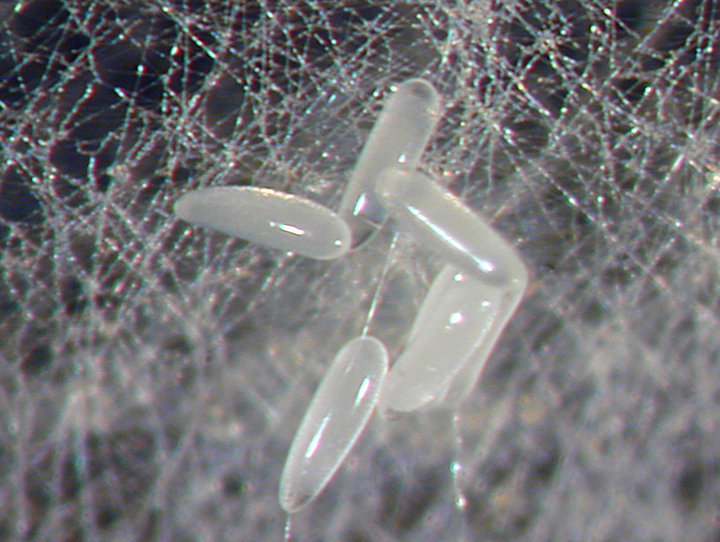by Jay F. Brunner, originally published 1993
(Hymenoptera: Eulophidae)

Colpoclypeus florus is a common ectoparasitoid attacking leafrollers (Lepidoptera: Tortricidae) in European orchards. It was first reported from North America when it parasitized nearly 80% of the leafroller larva in two unsprayed apple orchards in Washington during 1992. This discovery led to further investigation of this species, and it is now the primary hymenopteran parasitoid of leafrollers in Washington.
Hosts
In Europe, C. florus has been reported from several leafroller species from orchards and other crops. In Washington, it has been reared from the pandemis and obliquebanded leafroller. It could potentially attack all leafrollers found on fruit crops.
Life stages
Egg
The egg is slender and slightly curved and is less than 1/25 inch (1 mm) long. It is a creamy white color. Several eggs are laid by a single female on the webbing spun by the host larva within the leaf shelter.
Larva
The larva feeds externally and is found almost anywhere on the host’s body. It is maggot-like and usually bright to dull green in color. The first stage larva is less than 1/25 inch (1 mm) while the fully grown larva measures about 1/8 to 1/6 inch (3 to 4 mm).
Pupa
The pupa is found within the webbing spun by the host. It is light brown when first formed, gradually turns black and is 1/8 to 1/6 inch (3 to 4 mm) long. It has no cocoon and its appendages appearing to be glued to together.
Adult
The female has a black thorax with a light brown to golden abdomen. On the underside of the female’s abdomen are two small dark spots at the base of the ovipositor. The antennae are short. The male is slightly smaller than the female and has a black thorax and abdomen. It has a creamy white area on the underside of the abdomen.
Life history
The life history in the Pacific Northwest has not been studied, but information from European literature should be appropriate for conditions and hosts here. C. florus overwinter as mature larvae on the consumed host larva. They pupate in spring, and adults are present when leafroller larvae are present. The female stings a fourth or fifth instar larva and then remains with the larva inside the webbed leaf shelter.
C. florus begins feeding. Up to 50 or more C. florus may be produced from a single host larva. The development time from egg to adult is about 15 days at 75°F. There appear to be only two generations of C. florus in the Pacific Northwest, but more could be produced if hosts of suitable size were available.
Monitoring
C. florus can be sampled by searching shelters of mature larvae. The first sign that C. florus might be present is the density of the webbing in the shelter. The webbing of a leafroller larva stung by C. florus is 3 to 4 times denser than a that of a normal leafroller larva. Even if adult C. florus have emerged, the pupal skins remain and are a good clue to the presence of this parasitoid.
Management
Broad-spectrum insecticides are toxic to C. florus in Europe, but insect growth regulators and Bts are not. C. florus may not overwinter in high numbers because none of the leafrollers that are pests in orchards overwinter as late instar larvae, its preferred host size. Because C. florus is easily reared, it may be a candidate for augmentative release. This technique has been used in Europe with mixed results.




